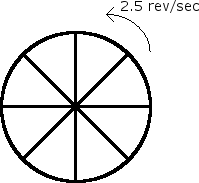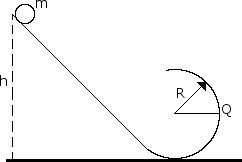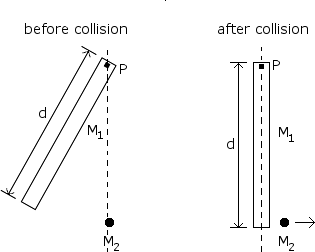Physics 1: Rotational Dynamics
The wheel shown below has eight equally spaced spokes and a radius of 30 cm. It is mounted on a fixed axle and is spinning at 2.5 rev/sec. You want to shoot a 20 cm long arrow without hitting any of the spokes. Assume the arrow and the spokes are very thin.

B. Does it matter where between the axle and the rim of the wheel you aim? If so what is the best location?
A flywheel turns through 40 rev as it slows from an angular speed of 1.5 rad/s to stop.
A. Assuming constant angular acceleration find the time for it to come to rest.
B. What is its angular acceleration?
C. How much time is required for it to complete its first 20 of the 40 revolutions?
A massless string is wrapped around a disk of rotational inertia I = . The disk falls and spins as it falls, unraveling the rope. Determine the tension in the string and the acceleration of the disk.

A solid brass sphere of mass m and radius r << R rolls along a track when released from rest along the straight section. The circular loop has a radius R.

B. Assume the sphere is released at height h = 6.0 R, what are the magnitude and direction of the horizontal force competent acting on the sphere at point Q?
A pulley of radius R1and rotational inertia I1is mounted on an axle with negligible friction. A light cord passing over the pulley has two blocks of mass mattached to either end, as shown below. Assume that the cord does not slip on the pulley. Determine the answers to parts (A) and (B) in terms of m, R1, I1, and fundamental constants.

An explorer plans a mission to place a satellite into a circular orbit around the planet Jupiter, which has a mass of M1= 1.90 x 1027kg and radius R1= 7.14 x 107m. A. If the radius of the planned orbit is R, use Newton’s laws to show each of the following.
The orbital speed of the planned satellite is give by v=
The period of the orbit is given by T=
B. The explorer wants the satellite’s orbit to be synchronized with Jupiter’s rotation. This requires an equatorial orbit whose period equals Jupiter’s rotation period of 9 hr 51 min = 3.55 x 105s. Determine the required orbital radius in meters. C. Suppose that the injection of the satellite into orbit is less than perfect. For an injection velocity that differs form the desired value in each of the following ways, sketch the resulting orbit on the figure. ( J is the center of Jupiter, the dashed circle is the desired orbit, and Pis the injection point.) Also, describe the resulting orbit qualitatively but specifically
When the satellite is at the desired altitude over the equator, its velocity vector has the correct direction, but the speed is slightly faster than the correct speed for a circular orbit of that radius.
When the satellite is at the desired altitude over the equation, its velocity vector has the correct direction but the speed is slightly slower than the correct speed for a circular orbit of that radius.

A light string that is attached to a large block of mass 4m passes over a pulley with negligible rotational inertia and is wrapped around a vertical pole of radius r, as shown below. The system is released from rest, and as the block descends the string unwinds and the vertical pole with its attached apparatus rotates. The apparatus consists of a horizontal rod of length 2L, with a small block of mass m attached at each end. The rotational inertia of the pole and the rod are negligible.

D. When the large block has descended a distance D, how does the instantaneous total kinetic energy of the three blocks compare to that in part (C), Greater, Equal, or Less?
A uniform disk is mounted to an axle and is free to rotate without friction. A thin uniform rod is rigidly attached to the disk so that it will rotate with the disk. A block is attached to the end of the rod. Properties of the disk, rod, and block are as follows.

C. Determine the linear speed of the mass at the end of the rod for the instant the rod is in the horizontal position.
A solid disk of unknown mass and known radius R is used as a pulley in a lab experiment as shown below. A small block of mass m is attached to a string, the other end of which is attached to the pulley and wrapped around it several times. The block of mass m is released from rest and takes a time t to fall the distance D to the floor.

D. The value of acceleration found in (B)iii, along with numerical values for the given quantities and your answer to (C), can be used to determine the rotational inertia of the pulley. The pulley is removed from its support and its rotational inertia is found to be greater than this value. Give one explanation for this discrepancy.
A uniform rod of mass M and length L is attached to a pivot of neglible friction as shown below. The pivot is located at a distance from the left end of the rod. Express all answers in terms of the given quantities and fundamental constants.

A system consists of a ball of mass and a uniform rod of mass and length . The rod is attached to a horizontal frictionless table by a pivot at point and initially rotates at an angular speed , pictured below on the left. The rotational inertia of the rod about point is . The rod strikes the ball, which is initially at rest. As a result of this collision, the rod is stopped and the ball moves in the direction shown on the right. Express all answers in terms of , , , , and fundamental constants.

D. A new ball with the same mass as the rod is now placed a distance from the pivot, as shown above. Again assuming the collision is elastic, for what value will the rod stop moving after hitting the ball?
In March 1999 the Mars Global Surveyor (GS) entered its final orbit about Mars, sending data back to Earth. Assume a circular orbit with a period of 1.18 x 10 minutes = 7.08 x 10 m/s. The mass of the GS is 930 kg and the radius of Mars is 3.43 x 10 m .
A. Calculate the radius of the GS orbit.
B. Calculate the mass of Mars.
C. Calculate the total mechanical energy of the GS in this orbit.
D. If the GS was to be placed in a lower circular orbit (closer to the surface of Mars), would the new orbital period of the GS be greater than or less than the given period?
E. In fact, the orbit of the GS entered was slightly eliptical with its closest approach to Mars at 3.71 x 10 m above the surface and its furthest distance at 4.36 x 10 m above the surface. If the speed of the GS at closest approach is 3.40 x 10 m/s, calculate the speed at the furthest point of the orbit.